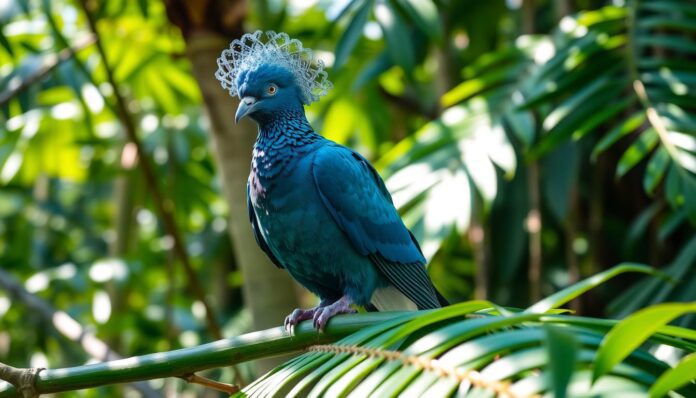Imagine a bird with a crown that rivals a royal’s. The Blue Crowned Pigeon is a bird of wonder, living in New Guinea’s rainforests. It’s known as Goura cristata and has a stunning blue crest, making it look regal and enchanting.
The Blue Crowned Pigeon is a true marvel of nature. It’s often called the “Bird of Paradise.” This bird shows the incredible beauty and diversity of tropical regions. As you explore its world, you’ll be amazed by its details and how it thrives in its habitat.
Blue Crowned Pigeon: An Introduction to Nature’s Royalty
The blue crowned pigeon, also known as the western crowned pigeon or victoria crowned pigeon, is a stunning bird. It belongs to the Columbidae family. This bird, from the lush forests of New Guinea and nearby islands, is a true marvel of nature.
Physical Characteristics and Size
The blue crowned pigeon can grow up to 76 cm (30 inches) tall. It’s one of the biggest pigeon species in the world. Its crown of feathers can reach 30 cm (12 inches) long, making it look regal and unique.
Its feathers are a deep blue-gray color. They also have iridescent green and purple shades that shine in sunlight.
Natural Distribution Range
The blue crowned pigeon lives in the tropical rainforests of New Guinea and nearby islands. These include Salawati, Misool, and Yapen. It thrives in the dense vegetation and diverse ecosystems of these areas.
In these regions, it plays a key role in the local ecosystem.
Taxonomic Classification
The blue crowned pigeon is part of the genus Goura. This genus is in the larger Columbidae family. The species, Goura cristata, is one of four in the Goura genus.
Other species in this genus include the western crowned pigeon, victoria crowned pigeon, and other pigeon species.
The Unique Features of Goura Cristata
The blue crowned pigeon, known as Goura cristata, is a standout in the crowned pigeon family. It has a stunning blue crest that can grow up to 12 inches long. This crest is one of the most striking features of the Goura cristata.
The bird’s feathers are a mix of gray, white, and black, giving it a regal look. Its wings have detailed patterns that add to its beauty. These features make the blue crowned pigeon truly unique.
Despite its size, the Goura cristata moves with grace and agility. It can hop from branch to branch in the dense forest canopy. This ability helps it thrive in its natural habitat, which we’ll discuss next.
| Feature | Description |
|---|---|
| Crest | Up to 12 inches in length, a stunning blue color |
| Plumage | Combination of gray, white, and black feathers, with intricat wing patterns |
| Agility | Capable of graceful movement through dense forest canopy |
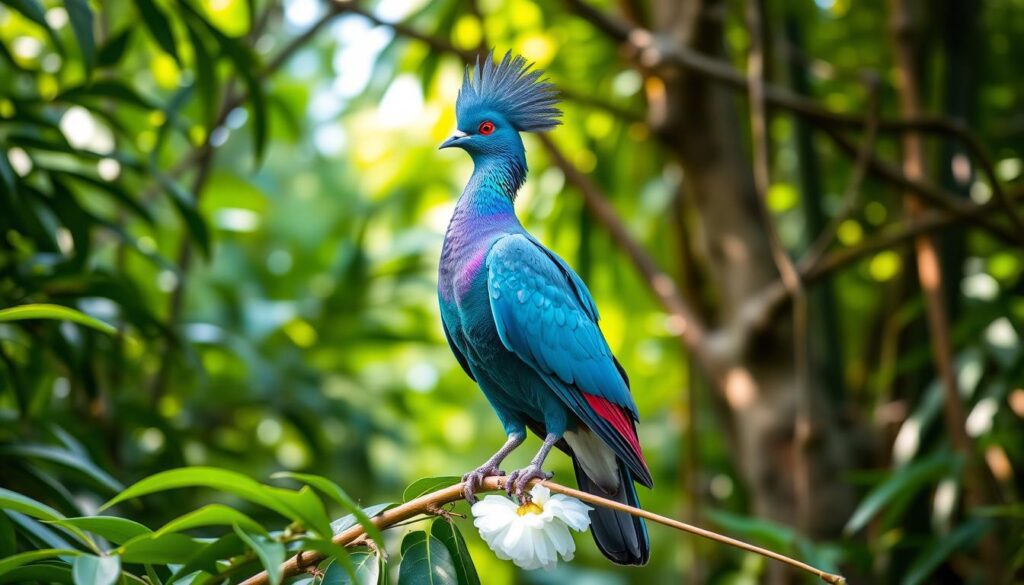
Habitat and Natural Environment
The lory pigeon, also known as the crested pigeons or large pigeons, is famous for its stunning looks and special habitat needs. These birds love the green, wet lowland rainforests. They find the perfect mix of shelter, food, and space to grow.
Forest Dwelling Preferences
The lory pigeon is in tune with the rainforest’s rhythm and variety. They prefer the dense, tree-covered parts of the forest. Here, they find plenty of food and safe places to nest.
They naturally seek the protection of tall trees. This keeps them safe from predators and harsh weather.
Territory and Space Requirements
As crested pigeons, the lory pigeon needs a lot of room to live well. They create big, private areas in the rainforest. They fiercely defend their territory to get to important resources and nesting spots.
This territorial behavior helps keep the forest ecosystem in balance.
Environmental Adaptations
The lory pigeon has amazing adaptations for living in the rainforest. Their bright colors and crest are not just for show. They also help the birds blend in with their green surroundings.
Their strong, flexible wings let them move easily through the forest’s complex landscape. They can quickly fly through the trees to find food and places to nest.
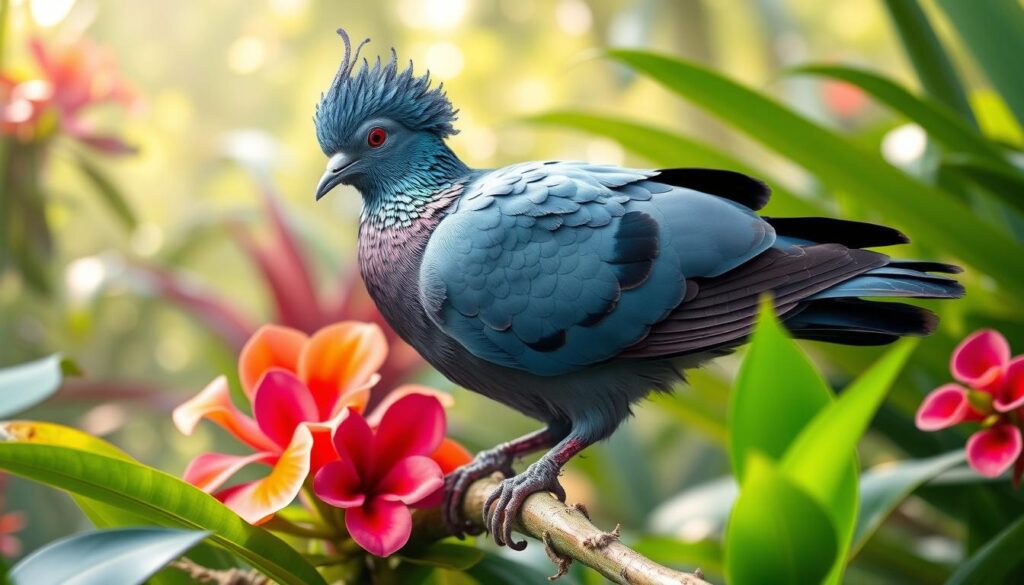
Diet and Feeding Behavior
The blue crowned pigeon, also known as the Goura cristata, is a fascinating bird from New Guinea’s dense forests. Its diet and feeding habits are closely linked to its environment and evolution.
This bird mainly forages on the ground. It eats fallen fruits, seeds, and berries from the undergrowth. Its strong, curved beak is perfect for eating these foods.
But the blue crowned pigeon also eats invertebrates like insects and small mollusks. This varied diet helps it stay healthy in its tropical home.
The bird’s feeding style is slow and careful. It uses its sharp eyes and nose to find food. When food is hard to find, it may look for it in the forest’s lower canopy.
| Food Source | Percentage of Diet |
|---|---|
| Fallen Fruits | 60% |
| Seeds | 25% |
| Berries | 10% |
| Invertebrates | 5% |
Learning about the blue crowned pigeon’s diet and foraging helps us understand its adaptations. It also shows us the balance in its forest home.

Social Structure and Behavior Patterns
The crowned pigeons, including the Victoria crowned pigeon and the western crowned pigeon, are fascinating creatures. They have complex social structures and unique behaviors. These birds of paradise show captivating mating rituals, dynamic flock dynamics, and distinct daily routines.
Mating Rituals
The mating rituals of crowned pigeons are a beautiful dance of courtship and pair bonding. They are known for their stunning crests and distinctive calls. Males perform elaborate courtship dances to win the affection of females and secure a lifelong partnership.
You May Like This : Polish Lowland Sheepdog: The Perfect Blend of Loyalty and Charm
Flock Dynamics
Crowned pigeons are highly social birds that live in small, tight-knit flocks. These flocks have a clear hierarchy, with dominant individuals leading the way. The birds communicate through vocalizations and body language to stay together and coordinate their activities.
Daily Activity Patterns
The daily lives of crowned pigeons are a balance between foraging, resting, and socializing. They are active in the early morning and late afternoon, foraging for fruits, seeds, and small invertebrates. They spend the rest of the day perched in the canopy, preening their feathers, and socializing with their flock mates.
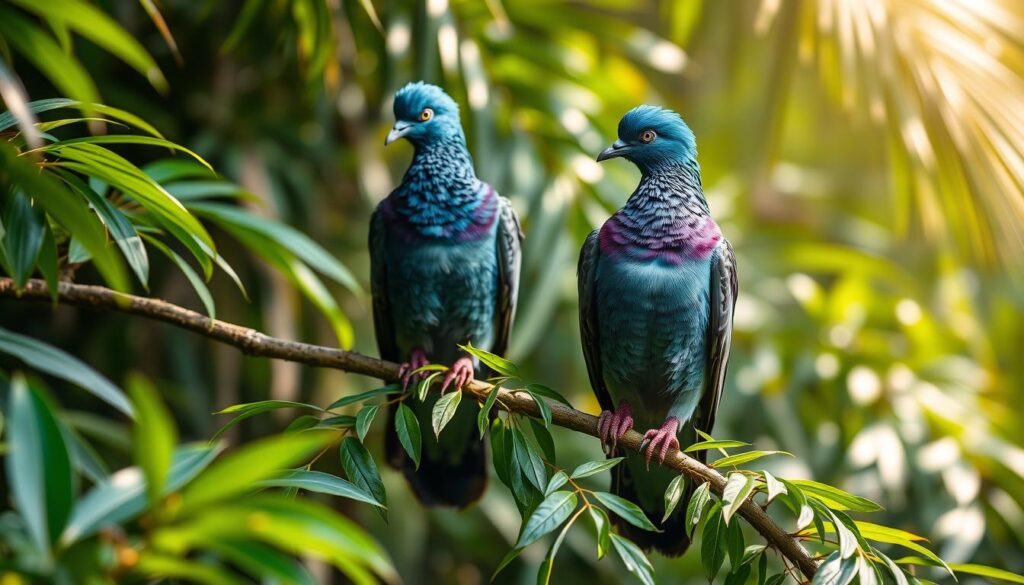
| Behavior | Description |
|---|---|
| Mating Rituals | Elaborate displays, crest fluffing, and cooing calls to attract mates and form lifelong partnerships. |
| Flock Dynamics | Hierarchical structure with dominant individuals, communication through vocalizations and body language. |
| Daily Activity Patterns | Foraging, resting, and social interactions, with peak activity in the early morning and late afternoon. |
Reproduction and Life Cycle
The blue crowned pigeon, known as Goura cristata, is a large pigeon found in New Guinea’s rainforests. Their reproductive cycle is fascinating and essential for their survival.
Courtship and Nesting: The male blue crowned pigeon shows off to attract a female. Once paired, they build a nest high in the forest canopy together.
Egg-Laying and Incubation: The female lays one egg, and both parents incubate it for 30 days. They protect the nest fiercely to ensure the egg hatches successfully.
Chick Rearing: After the chick hatches, both parents feed and care for it. The chick stays in the nest for weeks, growing stronger and eventually leaving the nest.
Lifespan and Factors: Goura cristata can live up to 20 years in the wild. But, threats like predation and habitat loss can affect their lifespan and ability to reproduce.

Conservation Status and Threats
The crowned pigeons, part of the Columbidae family, face big conservation challenges. These pigeon species are at risk, with the Blue Crowned Pigeon (Goura cristata) being the most threatened.
Current Population Trends
The Blue Crowned Pigeon’s numbers have been dropping for years. The IUCN says there are less than 10,000 of them worldwide. Some subspecies have even smaller populations.
Human Impact and Habitat Loss
The main danger to crowned pigeons is losing their homes. Deforestation, logging, and human settlements have cut down their habitats. Hunting and poaching for pets also hurt their numbers.
Protection Measures
- The Blue Crowned Pigeon is protected by CITES, which controls their trade.
- Efforts like saving habitats, stopping poaching, and breeding in captivity are underway.
- It’s important to raise awareness and involve communities in protecting these pigeon species.
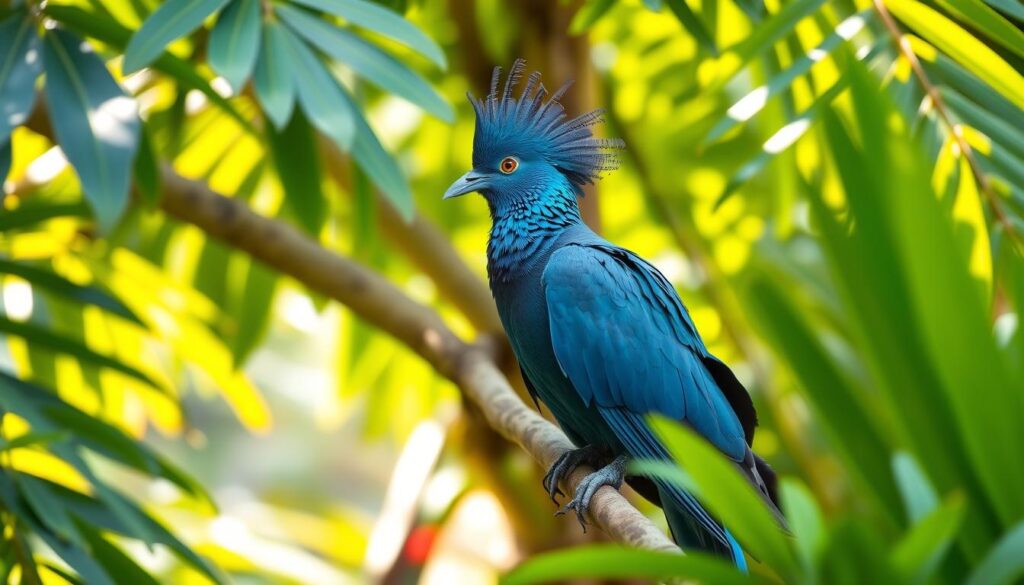
Protecting crowned pigeons is a big challenge. But with everyone working together, we can save these amazing pigeon species for future generations.
Comparison with Other Crowned Pigeon Species
The Blue Crowned Pigeon is part of a family with many unique species. Each one has special traits that make it stand out.
The Victoria Crowned Pigeon and Western Crowned Pigeon are also known for their stunning crests. They are called “pigeons of paradise” because of this. But, they look different from the Blue Crowned Pigeon.
The Victoria Crowned Pigeon is the biggest, with a wingspan of up to 1.5 meters. Its crest is very noticeable, with clear patterns. The Western Crowned Pigeon is smaller and has a more muted color, unlike the Blue Crowned Pigeon’s bright blues and whites.
These pigeons like the same kind of habitat, dense, humid forests. But, they live in different places. The Victoria Crowned Pigeon is only in New Guinea. The Western Crowned Pigeon is found in Indonesia and Malaysia. The Blue Crowned Pigeon lives in northeastern Australia.
Even though they look different, all these pigeons are amazing. They attract birdwatchers and nature lovers with their beauty and unique ways.
Cultural Significance and Human Relations
The blue crowned pigeon, known as Goura cristata, is very important to indigenous communities in New Guinea and nearby areas. For centuries, its stunning looks and special behaviors have been part of their stories and traditions. This lory pigeon is truly a treasure.
In many native cultures, the blue crowned pigeon stands for strength, elegance, and a deep bond with nature. It’s often seen in myths and stories as a bridge between the physical and spiritual worlds. Its unique crest and bright colors are found in many artworks, from wood carvings to ceremonial headdresses.
People’s connection with the Goura cristata goes beyond just symbols. In some places, its meat and feathers are used for food and clothes, but now, thanks to conservation, these practices are safer and more careful. The bird’s rare nature and love for certain habitats have made it a focus of local tracking and watching traditions.
| Cultural Significance | Human-Bird Interactions |
|---|---|
|
|
As we learn more about saving our planet’s diversity, the blue crowned pigeon has become even more special. Projects that involve local people are helping to protect this amazing bird. They also help keep the strong connection between the Goura cristata and the people who have always seen it as a part of their heritage.
Conclusion
The Blue Crowned Pigeon is a true marvel of nature. It has caught our attention throughout this journey. From its striking looks to its unique role in the ecosystem, it shows the beauty and diversity of birds.
We’ve learned a lot about the Blue Crowned Pigeon’s habitat, behavior, and conservation status. We’ve seen how it depends on its environment and the dangers it faces from humans. It’s our duty to protect this majestic bird and ensure it thrives for future generations.
Learning about the Blue Crowned Pigeon helps us appreciate the connection between all living things. It reminds us of nature’s fragility and strength, and our role in keeping it balanced. Let’s work together to save the Blue Crowned Pigeon and other crowned pigeon species. We must ensure their vibrant presence continues to enrich our world.
FAQ
What is the Blue Crowned Pigeon?
The Blue Crowned Pigeon, also known as the Goura Cristata, is a majestic bird. It lives in New Guinea and is known for its blue crest and elegant feathers.
What are the physical characteristics of the Blue Crowned Pigeon?
This bird is large, up to 30 inches long and 8 pounds heavy. Its blue crest is its most striking feature. The bird’s body is a mix of gray, white, and brown, making it look regal.
Where does the Blue Crowned Pigeon live?
It lives in New Guinea’s lowland rainforests and nearby islands. It can be found in Papua and West Papua, Indonesia, and parts of Papua New Guinea.
How is the Blue Crowned Pigeon classified taxonomically?
It belongs to the Columbidae family, which includes pigeons and doves. It’s the only species in the Goura genus. It’s closely related to other crowned pigeons.
What makes the Blue Crowned Pigeon unique?
Its stunning blue crest is unique. The bird is large, elegant, and lives on the ground. These traits make it stand out.
What is the natural habitat of the Blue Crowned Pigeon?
It lives in New Guinea’s lowland rainforests. It needs a specific territory and space to thrive. It has strong legs and lives on the ground.
What does the Blue Crowned Pigeon eat?
It eats plants like fruits, seeds, and leaves. It forages on the forest floor. Its strong beak and legs help it find food.
How do Blue Crowned Pigeons interact socially?
They live in small flocks and have complex social behaviors. They use their crests to communicate. They also have mating rituals and daily activities.
How do Blue Crowned Pigeons reproduce and what is their life cycle?
They have courtship and nesting behaviors. They lay one egg that both parents incubate. The chicks hatch after 30 days and are cared for until they can fend for themselves. They can live up to 20 years.
What is the conservation status of the Blue Crowned Pigeon?
It’s classified as Vulnerable on the IUCN Red List. Threats include habitat loss, hunting, and the pet trade. Conservation efforts are in place to protect it.
How does the Blue Crowned Pigeon compare to other crowned pigeon species?
It shares similarities with other crowned pigeons. But each species has unique features and adaptations.
What is the cultural significance of the Blue Crowned Pigeon?
It’s culturally important in New Guinea. It’s featured in traditional beliefs, stories, and art. It’s revered for its beauty and unique behaviors.


